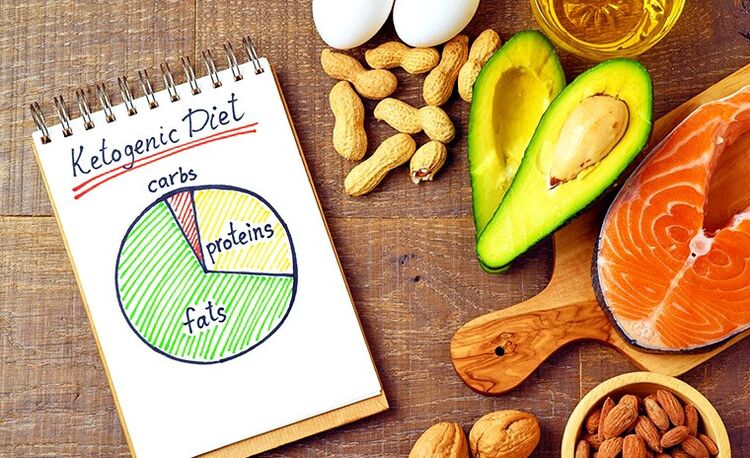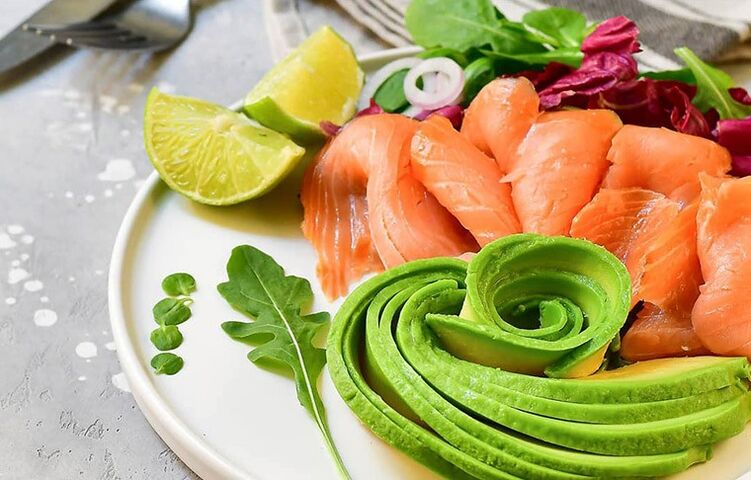
If, decades ago, someone put all the products in two baskets, sorting them according to the principle of maximum and minimum use, then today you would have to thoroughly review them. The strangest story happened during this period with fat - not only is mankind’s main enemy completely rehabilitated, but it almost asserted its savior. Is that so, nutritionist Chris More understands.
Recently, a patient admitted to me that she and her husband eat almost a kilogram of bacon a week - three slices for breakfast, followed by two more with a salad for lunch. I’ve been working as a nutritionist for over twenty years, and nothing seemed to surprise me, but then I couldn’t resist and I asked: why? The patient said her husband watched a TV show about the keto diet, and they decided to give it a try. Six months on bacon - and now the husband has lost nine kilograms and, according to his wife, is almost bursting with overwhelming energy.
Gradually, I hear from people about the miracles that the keto diet does for them. They claim that it burns fat in the body, kidnaps and overwhelms energy, and from now on, it is not only possible, but also as much bacon as you want to eat. But all their diligence requires at least a serious test - is there a keto diet that doesn't restrict animal fat intake as well?
The Ketogenic Diet is a low-carbohydrate diet high in fat and moderate in protein. It was first used in the treatment of epilepsy in children by increasing the body's level of ketones in the blood.
What is ketosis?
Let’s start with the name of the diet: where did this "keto" come from? When the body is short of enough carbohydrates - for example, due to diabetes or prolonged hunger - it has to break down its own fat more actively than usual to gain energy. Ketosis develops: metabolism is disrupted, and more ketone bodies accumulate than necessary in the tissues. Ketone bodies are products of fat metabolism. They are produced by the liver when insulin levels in the blood fall.
"The liver makes ketone bodies all the time, but its levels depend on the carbohydrates and proteins you eat - the body needs both, " explains Jeff Volek, a professor at the University of Ohio.
Fat breakdown in the body of a healthy person and the formation of ketone bodies is a normal process, called ketogenesis. Unlike ketosis, ketogenesis does not result in dramatic weight loss. Ketosis is a pathology that, in addition to diabetes and prolonged fasting, can lead to a keto diet, since it virtually eliminates carbohydrate foods from the diet. Someone who has developed ketosis loses a lot of weight, as well as some other pathologies.
The ketogenic diet forces the body to use fat as its main source of energy. Carbohydrates usually play this role, which, when taken with food, is processed into glucose, which is extremely important for the nutrition and function of the brain. However, if the diet is low in carbohydrates, the liver converts fat into its body fatty acids and ketones. Ketone bodies enter the brain and are used as a source of energy instead of glucose. An increase in the level of ketone bodies in the blood (ketosis) leads to a decrease in the incidence of epileptic seizures.
In the keto diet, most of the daily diet - from 60 to 80% - consists of fats, proteins - about 15%, and only the other 10% are carbohydrates (this is about half of a small base). At first glance, it looks like it’s on the Atkins diet, but the keto diet has a stricter carbohydrate restriction, according to Spencer Nadolsky, author of The Fat Loss Prescription. Some theorists generally argue that the less carbohydrates we eat, the more fat our body burns, and for this reason, metabolism improves, immunity increases - and in general, various miracles begin to happen to our body.
In everyday life, however, we get about half the calories, and not a tenth of them from carbohydrates. So, basically, the question is: can your body be in ketosis long enough to achieve the promised nirvana without serious health consequences? Will you start freaking out with fat?
Is the keto diet right for you?
It may feel weird, but the best diet for you is the one you are used to. As for Volek, who has been on keto for twenty years, she 's fine, but is she right for you? Unfortunately, there is no research on what happens in the body of a person who has been on the keto diet for a long time. During the A to Z Weight Loss Study, scientists studied the Atkins, Zone, LEARN and several other diets, but in the study, female subjects ate 25 to 35% of carbohydrates - this is nowhere near 10% who advise you to limit yourself to the keto diet.
The only thing that is known for sure: on the keto diet you really lose weight. In Italy, in 2015, they studied the performance of those who sat on it, and on average over three months they lost about 10-12 kilograms. A year earlier in Spain, he discovered that you can lose about 20 kilograms in a year. Indeed, over the next year, the subjects often returned to their pre-experimental weight, as soon as they dropped out of the strict diet.
What will you eat if you decide to give it a try? First and second, that bacon. Of the rest of the products, not many will suit you. Starchy vegetables - potatoes, pumpkin, corn - like most fruits are strictly prohibited. Milk, beans, rice and pasta must also be forgotten.
The keto diet is difficult to follow and can be dangerous for you. "Extreme diets, especially the keto diet, are strictly contraindicated in people with neurodegenerative diseases like epilepsy, " says Dr. Alan Aragon.
It is considered to be the best ketogenic diet in society for weight loss. However, according to scientific evidence, the effect of losing weight shortly after going on a ketonic diet is to reduce the amount of water in the body, and energy balance alone affects the amount of body fat. . For weight loss, the energy supplied by food should be less than the energy expended in physical activity. One of the benefits of the ketogenic diet, like other low-carb diets, is that ketosis that occurs with low-carb diets contributes to weight loss in obesity. The difference in calories consumed can be up to a thousand kilowatts per day compared to low-fat diets. The effect of ketogenic diets is highly dependent on protein content in the diet.
Can I take drugs that cause an increase in ketone bodies? Anyway. Don’t listen to those "consultants" who will assure you that you can induce ketosis with the help of special drugs even without any diet.
So is the keto diet right for you or not? If you are a very big athlete who is ready to try your body, if you like to take risks and fast results are important to you, then try again! If you just want to lose a few pounds and in the past you already had a "yo-yo effect" (when someone breaks down and after a strict diet and gained more weight than he didto lose), then maybe you should not risk it. However, if you go wise with the keto diet, there are three lessons you can learn from that will definitely come in handy.
- Reduce your intake of "empty" carbohydrates. Analyze the foods you get most of your daily carbohydrate intake: if it comes from fruits that are rich in fiber and antioxidants, then that’s okay, but if candy, soda and any food made withwhite flour your sources of carbohydrates, you know What to do: Do not hesitate to send them to the trash.
- Do not avoid fat. The passion for low-fat foods that began in the 90s can be safely abandoned in the past. Nothing good about that. Often, to compensate for the lack of fat, manufacturers increase the amount of sugar in such products. Eat fatty fish like salmon, mackerel, or sardines at least twice a week. And whatever you cook, don’t skip vegetables, especially good olive oil.
- Eat plenty of green. All vegetables and leafy vegetables go well with fatty and protein foods - many of them are eaten by fans of the keto diet. And you do the same. Eat cabbage, spinach, bok choy, arugula and other types of salads without restrictions.
What happened to my bacon patients? Their experiments with nutrition continued right up until the moment their baby was born. Of course, they immediately forgot about the diet (there is no time to think about it, as the young mother explained). So remember: sooner or later you will get tired of filling up bacon regularly and return to a familiar routine.
Oidis

Salmon and asparagus salad
Ingredients:
- 150 g salmon fillet;
- Green asparagus 80 g;
- 1/2 head iceberg lettuce;
- 2 eggs;
- 4 anchovy fillets;
- 5 cherry tomatoes;
- 5 large horses (or 6–8 small ones) - take capers in salt, not brine, they must be washed before use;
- 1/2 medium red onion;
- 6-8 Art. l. olive oil;
- 1 tspmustaird dijon;
- juice of half a lemon.
How to cook:
- If you have ever cooked nicoise, you can also handle this salad. It practically repeats the main dish of Nice, only fat salmon is taken instead of tuna, and asparagus is used instead of green beans (however, you can also use beans).
- Salmon is best cooked not in a hot frying pan or oven, but steamed or in a slow cooker: 20-30 minutes at a temperature of 80-85 degrees, not higher (otherwise the protein will curl upand the fish will turn out tough). But you can also fry in a pan (don’t forget it! ) - the fish should be tender and keep some transparency inside.
- Cook asparagus. It must be crisp, so don’t overcook it! Cooking time depends on its size, so it is not recommended to leave the stove - asparagus cooks quickly.
- Place the deformed iceberg on a plate (the salad needs to be washed, dried and shredded into medium pieces), disassemble asparagus, salmon into large pieces, half cherry tomatoes, anchovies, capers, chopped onions into rings and hard boiled eggs(ideally, the yolk should remain liquid but soft). Top the fields with olive oil sauce with Dijon mustard and lemon juice. You don’t have to salt the dish - anchovies and capers are already salty.
Athletes involved in staying in sports that require endurance use the ketogenic diet, such as ultramarathon, triathlon, cycling, etc. Athletes who adhere to this diet use fat in a more efficient way as a source of energy and thus help preserve glycogen stores during prolonged exertion.
Bacon and lettuce salad
Ingredients:
- 2 palm size lettuce heads
- 100 g bacon;
- 8 sprigs of mint;
- 1 egg yolk;
- 6 tbsp. l. olive oil and a little more for frying;
- 1 tspmustaird granular;
- 1 tbsp. l. sheriff vinegar.
How to cook:
- For this salad, you will need to make a sauce that is a little more complicated: put mint leaves and mustard in a tall glass, add egg yolk, pour in sherry vinegar. Whisk with a blender and add olive oil in a thin stream.
- Cut the lettuce in half lengthwise and fry quickly over high heat. It should caramelize a little, that is, get a golden brown color, staying fresh and crispy on the inside. Fry the bacon over high heat without oil or in the oven until crisp. Place lettuce, bacon and sauce on a plate. Garnish with mint leaves.














































































